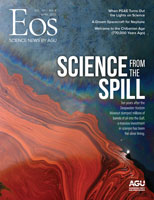On 20 April 2010, a bubble of methane shot up an oil and gas well in the Gulf of Mexico and ignited when it reached the surface, killing 11 crew members and starting an uncontrollable fire on the Deepwater Horizon drilling rig. Given the catastrophic emergency, it wasn’t until the rig sank 2 days later that anyone realized oil was being released into the Gulf. Not just spilling—gushing out from the well at the seabed at an enormous rate.
That’s when Jerry Miller—Eos’s science adviser representing AGU’s Ocean Sciences section—was called to action. Miller was serving as assistant director for ocean sciences at the White House Office of Science and Technology Policy (OSTP), a leader of the team developing the first National Ocean Policy.
Miller, who had previously lived on the Gulf Coast, and his coworkers were surprised by the initial scale of the explosion. He was heartened, however, by the broad government response, including several science agencies, and that was only the beginning. “Shortly after the event, and especially after a couple of weeks passed and the enormity of the oil spill started to become apparent, we began to receive offers of assistance from colleagues throughout the scientific community,” Miller told me as he recalled the events. “Our scientific community stepped up and reshaped their own carefully designed research plans to focus on the Deepwater event.”
Miller remembered one day a few weeks after the explosion, when OSTP needed experts to brief the White House and agency leaders. “On less than 24 hours’ notice and at their own expense, several dozen scientists flew into Washington to provide their advice,” said Miller. “Person after person for hours on end, old hands and new stepped to the podium and offered their expertise to serve the nation’s needs.”
The very worst situation brought out the very best in the science community. It’s certainly the theme of the story we tell in “Modeling Under Pressure,” when hydrologist Paul Hsieh was called on to work through the night, by himself, to make an expert call on whether the cap BP had placed on its well would hold.
This month, on the tenth anniversary of the Deepwater Horizon disaster, we dedicate this issue of Eos to this community that not only pulled together in the moment but created massive collaborations dedicated to research in the Gulf that continue today.
The Deepwater Horizon Project Tracker is following more than 1,200 projects using some of the $4.14 billion allocated for science and related environmental and educational programs.
Tens of billions of dollars came out of lawsuit settlements and other penalties against the companies involved, and a sizable amount of that was set aside to fund research. The Deepwater Horizon Project Tracker is following more than 1,200 projects using some of the $4.14 billion allocated for science and related environmental and educational programs.
One of the organizations created to run these projects is the Gulf of Mexico Research Initiative, or GoMRI. In “Deepwater Horizon and the Rise of the Omics,” read more about one of these GoMRI projects. In that article, Joel E. Kostka and his coauthors write, “The DWH spill was also the first major environmental disaster for which genomics technologies had matured to such an extent that they could be deployed to quantify microbial responses over large spatial and temporal scales.” Microbes were already part of an environment’s natural response to oil spills. Today scientists have the gene sequencing techniques to properly study the role microbes play and the mechanisms with which they break down oil—with the hope that one day we might be able to deploy them deliberately to protect or restore the environment around a spill.
Visit Eos.org throughout April for more coverage of the science and community efforts that came out what’s now considered to be the largest oil spill in history. Our thanks go to Miller and the other scientists who have made this issue possible, and we hope you’re inspired by the bravery and vision shown by everyone who rose to this challenge.
—Heather Goss (@heathermg), Editor in Chief
Citation:
Goss, H. (2020), Deepwater Horizon’s legacy of science, Eos, 101, https://doi.org/10.1029/2020EO141787. Published on 25 March 2020.
Text © 2020. AGU. CC BY-NC-ND 3.0
Except where otherwise noted, images are subject to copyright. Any reuse without express permission from the copyright owner is prohibited.
Text © 2020. AGU. CC BY-NC-ND 3.0
Except where otherwise noted, images are subject to copyright. Any reuse without express permission from the copyright owner is prohibited.


